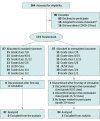Effect of Wearing a Face Mask on Hand-to-Face Contact by Children in a Simulated School Environment: The Back-to-School COVID-19 Simulation Randomized Clinical Trial
- PMID: 36279142
- PMCID: PMC9593317
- DOI: 10.1001/jamapediatrics.2022.3833
Effect of Wearing a Face Mask on Hand-to-Face Contact by Children in a Simulated School Environment: The Back-to-School COVID-19 Simulation Randomized Clinical Trial
Abstract
Importance: Wearing a face mask in school can reduce SARS-CoV-2 transmission but it may also lead to increased hand-to-face contact, which in turn could increase infection risk through self-inoculation.
Objective: To evaluate the effect of wearing a face mask on hand-to-face contact by children while at school.
Design, setting, and participants: This prospective randomized clinical trial randomized students from junior kindergarten to grade 12 at 2 schools in Toronto, Ontario, Canada, during August 2020 in a 1:1 ratio to either a mask or control class during a 2-day school simulation. Classes were video recorded from 4 angles to accurately capture outcomes.
Interventions: Participants in the mask arm were instructed to bring their own mask and wear it at all times. Students assigned to control classes were not required to mask at any time (grade 4 and lower) or in the classroom where physical distancing could be maintained (grade 5 and up).
Main outcomes and measures: The primary outcome was the number of hand-to-face contacts per student per hour on day 2 of the simulation. Secondary outcomes included hand-to-mucosa contacts and hand-to-nonmucosa contacts. A mixed Poisson regression model was used to derive rate ratios (RRs), adjusted for age and sex with a random intercept for class with bootstrapped 95% CIs.
Results: A total of 174 students underwent randomization and 171 students (mask group, 50.6% male; control group, 52.4% male) attended school on day 2. The rate of hand-to-face contacts did not differ significantly between the mask and the control groups (88.2 vs 88.7 events per student per hour; RR, 1.00; 95% CI, 0.78-1.28; P = >.99). When compared with the control group, the rate of hand-to-mucosa contacts was significantly lower in the mask group (RR, 0.12; 95% CI, 0.07-0.21), while the rate of hand-to-nonmucosa contacts was higher (RR, 1.40; 95% CI, 1.08-1.82).
Conclusions and relevance: In this clinical trial of simulated school attendance, hand-to-face contacts did not differ among students required to wear face masks vs students not required to wear face masks; however, hand-to-mucosa contracts were lower in the face mask group. This suggests that mask wearing is unlikely to increase infection risk through self-inoculation.
Trial registration: ClinicalTrials.gov Identifier: NCT04531254.
Conflict of interest statement
Figures
References
-
- Chu DK, Akl EA, Duda S, Solo K, Yaacoub S, Schünemann HJ; COVID-19 Systematic Urgent Review Group Effort (SURGE) study authors . Physical distancing, face masks, and eye protection to prevent person-to-person transmission of SARS-CoV-2 and COVID-19: a systematic review and meta-analysis. Lancet. 2020;395(10242):1973-1987. doi:10.1016/S0140-6736(20)31142-9 - DOI - PMC - PubMed
Publication types
MeSH terms
Associated data
LinkOut - more resources
Full Text Sources
Medical
Miscellaneous



